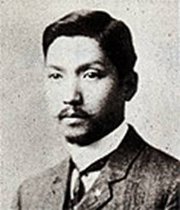About Osugi Sakae

Osugi Sakae (大杉 栄 Ōsugi Sakae, January 17, 1885–September 16, 1923) was a radical individualist and anarchist. He published numerous anarchist periodicals, helped translate various western anarchist essays into Japanese for the first time, and created Japan's first Esperanto school in 1906. He, Noe Itō, and his nephew were murdered in what became known as the Amakasu Incident.
Text and image from http://en.wikipedia.org/wiki/Osugi_Sakae
I am not Ōsugi Sakae. My name is Chris Spackman and I studied Ōsugi Sakae's life and writings in grad school before going to Japan. This is my personal website. My history-related web stuff is at www.openhistory.org but be warned that I have not updated that site in quite some time.
I've not given up on OpenHistory, but now spend most of my time working with my ESL students at The Charles School at Ohio Dominican University and the other schools in the Graham Family of Schools. I also teach at the Language Institute at Columbus State Community College.
About Chris Spackman
Below are a few things about me.
TESOL
I lived and worked in Japan for many years. I was in Wajima-shi, Ishikawa-ken on the JET Program from 1995 to 1998. Then, I worked for Kanazawa City, helping to create and run an English as a Foreign Language program for the city's 58 elementary schools. That was from 1998 until 2008. My wife and I left Japan and came to Ohio in 2008. I earned my MA in TESOL from Ohio Dominican University in 2010. I've been teaching with The Graham Family of Schools since the 2010-2011 school year.
From 2011 through 2018, I taught TSL 570 in the summer at Ohio Dominican University. TSL 570 is sort of a "tech for teachers" class in the MA TESOL program. In 2015 I started teaching ESL part time with Columbus State Community College on weekends.
Linux / Open Source Software

I started using Linux in 1998 and have used it full time at home since 1999. I've tried most of the big famous distros, including Caldera (before they were evil), Red Hat, Debian, Mandrake, PCLinuxOS, Ubuntu, Arch, and Gentoo. My main distro at home is Gentoo and on laptops, these days, it is usually Xubuntu. I'm a fan of XFCE, Fluxbox, and i3wm. I was a fan of KDE until KDE4.0.
I'm sorry, but anyone who thinks that Linux is not suitable for the desktop is wrong. My wife uses Xubuntu and does everything she needs to do. She doesn't know or care that it is Linux. Me, I use the command line / terminal for almost everything. You couldn't pay me to switch full time to a graphics-based environment.
Open Content / Free Content
I started OpenHistory and the Japanese History Documentation Project (JHDP) around 1998-ish, although it was not originally at the OpenHistory.org web site. This is about 2 years before Wikipedia started.
At the time, several other people and groups were also trying to find a suitable way to replicate the Open Source software model with content. GNU released their Free Documentation License (GFDL) in 1999 / 2000, and if I remember correctly, there was an open content license from another group previous to the GFDL. The Creative Commons organization was founded in 2001 and they released their first open licenses in 2002. So, open content was certainly in the air around the turn of the century.
In retrospect, the issue that held back open content was not the licenses as much as the technology for collaborating. I put in many hours of work on the JHDP, and I am proud of that work, but in the years that I was doing it, only 2 or 3 people submitted any work to it. We communicated by email and they sent their submissions as text or (shudder) MS Word documents. Obviously, that was not going to scale well.
Wikipedia solved the problem by creating the technology to allow people to collaborate on documentation projects online, without the need to learn CMS or git-like push-pull-commit software. Free / Open Content finally reached not-technical users, and the results speak for themselves.
As I said, I'm proud of the work I put into the Japanese History Documentation Project and OpenHistory. I am happy to say that some of my work was put into Wikipedia.
Other sites with which I am (was) involved
OpenHistory: Home of the Japanese History Documentation Project (JHDP)
ChrisSpackman.com: Home of my TESOL / ESOL materials and other professional work. OsugiSakae.com is more for my personal stuff.
Karate the Japanese Way (closed): KtJW was my friend Mark Groenewold's excellent karate site. It was a companion to his book "Karate the Japanese Way". I don't do karate but I do do HTML, so I helped him create and maintain it. The content was first rate and the forums were full of great karate practitioners. For a while, KtJW was the most popular karate-related site on the Web. Unfortunately, Mark had to move on, and he made the tough decision to shut it down rather than do a less than awesome job with it. If you are into Japanese culture and especially Karate, I highly recommend his book "Karate the Japanese Way".
Whipped! Card Game (closed): Mark Groenewold and some friends put together a fun card game about relationships. They named their game “Whipped” and I helped put together the web site for it.
Contact Details
- E-mail: chris { at } osugisakae { dot } com or chris { at } chrisspackman { dot } com
- Mastodon: { at } chrisspackman { at } twit { dot } social
- I don't use instant messaging much because all the old, open, systems seem to be gone.
